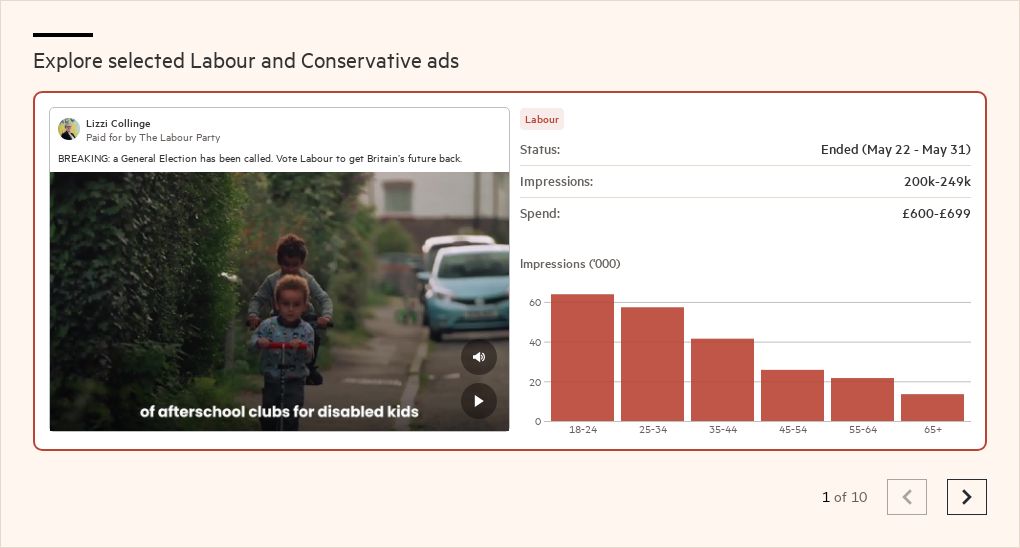Unlock the Editor’s Digest for free
Roula Khalaf, Editor of the FT, selects her favourite stories in this weekly newsletter.
Labour candidates far outspent the Conservatives on Facebook and Instagram during a crucial window early in the UK general campaign when limits on local spending were looser, a Financial Times analysis has found.
Sir Keir Starmer’s opposition party spent over £900,000 on adverts for individual candidates in the days after Prime Minister Rishi Sunak called the election, compared to just £176,000 for the ruling Conservatives.
The figures show Labour took greater advantage of the nine-day window between Sunak’s announcement on May 22 and the dissolution of Parliament, when stricter spending limits were not yet in force.
One Labour campaigner said the blitz had helped their candidate get “name recognition on the doorstep” early in the campaign.
The difference in approach may be a sign of disorganisation in the Tory campaign, even though Sunak chose to call an early election for July 4.
The Conservatives had to hurry to find people to contest seats across the country, whereas Labour had already selected most of its candidates when Sunak kicked off the campaign.
Both parties have spent similar sums on adverts from their national party and leaders pages, though Labour spent larger sums in the days after the election was called.
Up until June 4, Labour had spent £1.4mn in total while the Tories had spent £660,000, with the difference largely due to Labour’s candidate spending.
Labour’s adverts have targeted younger voters where it has typically had strong support, whereas the Conservatives focused on older people who have historically made up its base.
The majority of Tory ads are shown to voters above 55, and many are were seen by more men than women. One series reflected the party’s fear of losing votes to Reform UK on their right: “A vote for Reform is a vote for Keir Starmer.”
Overall, the main parties have had similar number of impressions on Meta platforms, with Labour leading at 135mn, compared to 121mn for the Tories up until June 5 — indicating that the Conservatives’ lower spending has been more efficient.
Social media platforms typically charge advertisers a premium for targeting younger users and within specific geographic areas, both elements of Labour’s strategy.
“It depends on how narrowly you are targeting an audience. If it’s granular and super narrow, it’s more expensive,” said Clare O’Donoghue Velikić, who previously led a team at Facebook that handled UK political marketing.
Neither Labour nor the Conservatives responded to requests to comment.
UK election rules limit per-candidate spending depending on the number of voters in the constituency, with the maximum around £20,000. The cap covers all expenses, not only advertising. It kicked in on May 30.
The parties also have nationwide spending limits of around £35mn, which increased from £19.5mn in 2019. To benefit from this higher cap, party spending must not identify specific candidates and constituencies.
Thirty Labour candidates spent more than £10,000 during the nine-day window. The biggest spend of £22,000 was for the Labour candidate in the wealthy Tory stronghold constituency of Chelsea and Fulham.
Only three Conservative candidates spent more than £10,000 during the same period, including defence secretary Grant Shapps in Welwyn Hatfield.
Labour’s digital ad strategy appeared to be more centrally planned. Its adverts included co-ordinated campaigns spread across the Facebook and Instagram pages of candidates in hundreds of constituencies.
Immediately after Sunak’s announcement, 166 Labour candidates posted ads with personal videos captioned “BREAKING: A general election has been called.” These ads cost £150,000 and received more than 12mn impressions, introducing their candidates to millions of potential voters.
The Labour campaigner said that party headquarters had helped them produce these videos weeks in advance, offering strategy tips and even becoming administrators on their Facebook page to run ads on their behalf.
The Conservatives responded to Labour’s co-ordinated rollout with a series of video ads captioned “Clear Plan. Bold Action. Secure Future”.
These ads were run across the pages of 39 candidates, but only launched on May 28 and were halted on May 30 once the lower per-candidate spending rules applied. The Tories spent £9,000 on these ads.
Tom Hamilton, a former Labour staffer from 2008-2018 and now a director at Public First, said the different approach may stem from Tory candidates seeing little benefit in working closely with the central party.
“It’s less a story about how the parties are structured, and as much a story about who’s winning and who’s losing,” he said.
The Tories currently trail Labour by 21 points in polling, according to the FT’s poll tracker. Some Tory candidates have avoided highlighting or mentioning the party’s or Sunak’s name in their campaign materials.
“When you’re running a campaign that looks like it’s winning, it’s easier to get [candidates] to buy into your central messaging and brand,” said Hamilton.

















